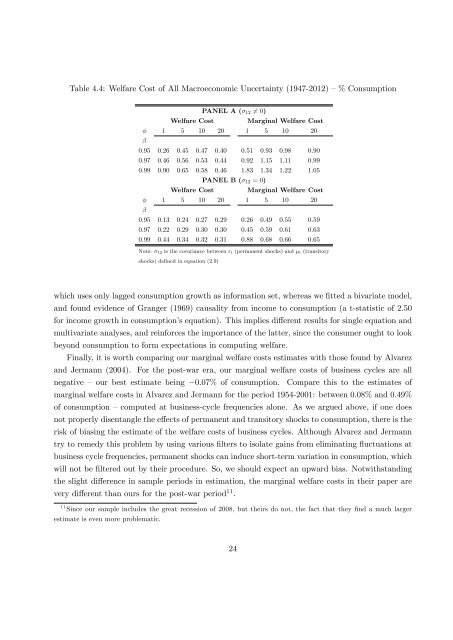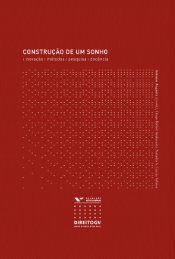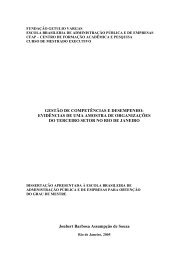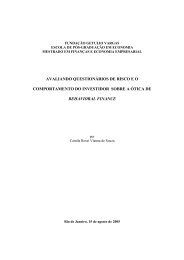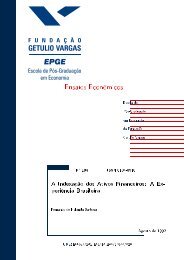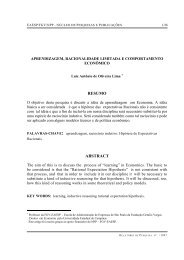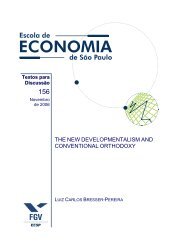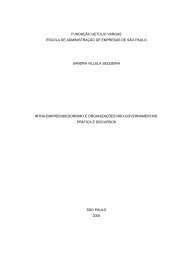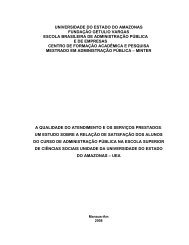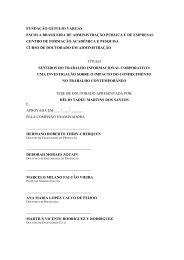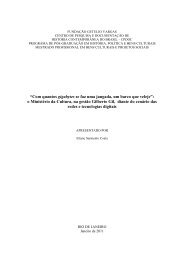Ensaios Econômicos - Sistema de Bibliotecas da FGV - Fundação ...
Ensaios Econômicos - Sistema de Bibliotecas da FGV - Fundação ...
Ensaios Econômicos - Sistema de Bibliotecas da FGV - Fundação ...
Create successful ePaper yourself
Turn your PDF publications into a flip-book with our unique Google optimized e-Paper software.
Table 4.4: Welfare Cost of All Macroeconomic Uncertainty (1947-2012) –% Consumption<br />
PANEL A ( 12 6= 0)<br />
Welfare Cost<br />
Marginal Welfare Cost<br />
1 5 10 20 1 5 10 20<br />
<br />
0.95 0.26 0.45 0.47 0.40 0.51 0.93 0.98 0.90<br />
0.97 0.46 0.56 0.53 0.44 0.92 1.15 1.11 0.99<br />
0.99 0.90 0.65 0.58 0.46 1.83 1.34 1.22 1.05<br />
PANEL B ( 12 = 0)<br />
Welfare Cost<br />
Marginal Welfare Cost<br />
1 5 10 20 1 5 10 20<br />
<br />
0.95 0.13 0.24 0.27 0.29 0.26 0.49 0.55 0.59<br />
0.97 0.22 0.29 0.30 0.30 0.45 0.59 0.61 0.63<br />
0.99 0.44 0.34 0.32 0.31 0.88 0.68 0.66 0.65<br />
Note: 12 is the covariance between " t (permanent shocks) and t (transitory<br />
shocks) <strong>de</strong>…ned in equation (2.9)<br />
which uses only lagged consumption growth as information set, whereas we …tted a bivariate mo<strong>de</strong>l,<br />
and found evi<strong>de</strong>nce of Granger (1969) causality from income to consumption (a t-statistic of 2.50<br />
for income growth in consumption’s equation). This implies di¤erent results for single equation and<br />
multivariate analyses, and reinforces the importance of the latter, since the consumer ought to look<br />
beyond consumption to form expectations in computing welfare.<br />
Finally, it is worth comparing our marginal welfare costs estimates with those found by Alvarez<br />
and Jermann (2004). For the post-war era, our marginal welfare costs of business cycles are all<br />
negative – our best estimate being 0:07% of consumption. Compare this to the estimates of<br />
marginal welfare costs in Alvarez and Jermann for the period 1954-2001: between 0:08% and 0:49%<br />
of consumption – computed at business-cycle frequencies alone. As we argued above, if one does<br />
not properly disentangle the e¤ects of permanent and transitory shocks to consumption, there is the<br />
risk of biasing the estimate of the welfare costs of business cycles. Although Alvarez and Jermann<br />
try to remedy this problem by using various …lters to isolate gains from eliminating ‡uctuations at<br />
business cycle frequencies, permanent shocks can induce short-term variation in consumption, which<br />
will not be …ltered out by their procedure. So, we should expect an upward bias. Notwithstanding<br />
the slight di¤erence in sample periods in estimation, the marginal welfare costs in their paper are<br />
very di¤erent than ours for the post-war period 11 .<br />
11 Since our sample inclu<strong>de</strong>s the great recession of 2008, but theirs do not, the fact that they …nd a much larger<br />
estimate is even more problematic.<br />
24


